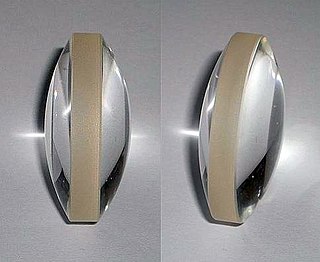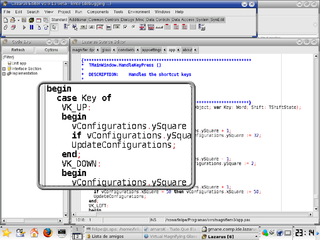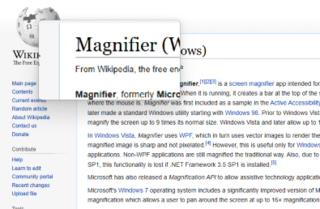
Assistive technology (AT) is assistive, adaptive, and rehabilitative devices for people with disabilities or the elderly population. People who have disabilities often have difficulty performing activities of daily living (ADLs) independently, or even with assistance. ADLs are self-care activities that include toileting, mobility (ambulation), eating, bathing, dressing, grooming, and personal device care. Assistive technology can ameliorate the effects of disabilities that limit the ability to perform ADLs. Assistive technology promotes greater independence by enabling people to perform tasks they were formerly unable to accomplish, or had great difficulty accomplishing, by providing enhancements to, or changing methods of interacting with, the technology needed to accomplish such tasks. For example, wheelchairs provide independent mobility for those who cannot walk, while assistive eating devices can enable people who cannot feed themselves to do so. Due to assistive technology, people with disabilities have an opportunity of a more positive and easygoing lifestyle, with an increase in "social participation," "security and control," and a greater chance to "reduce institutional costs without significantly increasing household expenses."

A lens is a transmissive optical device that focuses or disperses a light beam by means of refraction. A simple lens consists of a single piece of transparent material, while a compound lens consists of several simple lenses (elements), usually arranged along a common axis. Lenses are made from materials such as glass or plastic, and are ground and polished or molded to a desired shape. A lens can focus light to form an image, unlike a prism, which refracts light without focusing. Devices that similarly focus or disperse waves and radiation other than visible light are also called lenses, such as microwave lenses, electron lenses, acoustic lenses, or explosive lenses.
Computer accessibility refers to the accessibility of a computer system to all people, regardless of disability type or severity of impairment. The term accessibility is most often used in reference to specialized hardware or software, or a combination of both, designed to enable use of a computer by a person with a disability or impairment. Computer accessibility often has direct positive effects on people with disabilities.
A screen reader is a form of assistive technology that is essential to people who are blind, as well as useful to people who are visually impaired, illiterate, or have a learning disability. Screen readers are software applications that attempt to convey what people with normal eyesight see on a display to their users via non-visual means, like text-to-speech, sound icons, or a Braille device. They do this by applying a wide variety of techniques that include for example interacting with dedicated Accessibility API, using various operating system features and employing hooking techniques.
A screen magnifier is software that interfaces with a computer's graphical output to present enlarged screen content. By enlarging part of a screen, people with visual impairments can better see words and images. This type of assistive technology is useful for people with some functional vision; people with visual impairments and little or no functional vision usually use a screen reader.

A magnifying glass is a convex lens that is used to produce a magnified image of an object. The lens is usually mounted in a frame with a handle. A magnifying glass can be used to focus light, such as to concentrate the sun's radiation to create a hot spot at the focus for fire starting.
An optical instrument is a device that either processes light waves to enhance an image for viewing, or to analyze and determine their characteristic properties. Common examples include periscopes, microscopes, telescopes, and cameras.
ZoomText is a screen magnifier for Microsoft Windows, developed by Ai Squared which was acquired by Freedom Scientific in 2016. The first version was released for DOS in 1988, and the first version for Windows was released in 1991. ZoomText is available in two editions: ZoomText Magnifier and ZoomText Magnifier/Reader, which includes a built-in screen reader.
Visual impairment, also known as vision impairment or vision loss, is a decreased ability to see to a degree that causes problems not fixable by usual means, such as glasses. Some also include those who have a decreased ability to see because they do not have access to glasses or contact lenses. Visual impairment is often defined as a best corrected visual acuity of worse than either 20/40 or 20/60. The term blindness is used for complete or nearly complete vision loss. Visual impairment may cause people difficulties with normal daily activities such as driving, reading, socializing, and walking.

Virtual Magnifying Glass is an open-source, screen magnification tool for Microsoft Windows and Linux.

A curved mirror is a mirror with a curved reflecting surface. The surface may be either convex or concave. Most curved mirrors have surfaces that are shaped like part of a sphere, but other shapes are sometimes used in optical devices. The most common non-spherical type are parabolic reflectors, found in optical devices such as reflecting telescopes that need to image distant objects, since spherical mirror systems, like spherical lenses, suffer from spherical aberration. Distorting mirrors are used for entertainment. They have convex and concave regions that produce deliberately distorted images. They also provide highly magnified or highly diminished (smaller) images when the object is placed at certain distances.
A magnifier is a device used for magnification.

A reading stone is an approximately hemispherical lens that can be placed on top of text to magnify the letters so that people with presbyopia can read it more easily. Reading stones were among the earliest common uses of lenses.
In optometry, the least distance of distinct vision (LDDV) or the reference seeing distance (RSD) is the closest someone with "normal" vision can comfortably look at something. In other words, LDDV is the minimum comfortable distance between the naked human eye and a visible object.

The Buffalo & Erie County Public Library is located on Lafayette Square, Buffalo, New York. The current facility, designed by Kideney Architects and built in 1964, replaced the original Cyrus Eidlitz Buffalo Public Library Building dedicated in February 1887. The first Buffalo Public Library, in turn, replaced the Erie County, New York courthouse, which occupied the parcel from 1816-1876.

This article is about tools for visually-impaired people. For image-processing techniques not related to the visually impaired, please create other articles such as Eulerian video magnification.

ThunderHawk is a discontinued web browser from Bitstream available for a full range of operating systems in high end and mass-market mobile phones and personal digital assistants. It is basically meant for mobile operators and original equipment manufacturers and not meant to download for normal users.

Magnifier, formerly Microsoft Magnifier, is a screen magnifier app intended for visually impaired people to use when running Microsoft Windows. When it is running, it creates a bar at the top of the screen that greatly magnifies where the mouse is. Magnifier was first included as a sample in the Active Accessibility SDK/RDK for Windows 95 and later made a standard Windows utility starting with Windows 98. Prior to Windows Vista, Magnifier could be used to magnify the screen up to 9 times its normal size. Windows Vista and later allow up to 16× magnification.
Telesensory Systems, Inc. (TSI) was an American corporation that invented, designed, manufactured, and distributed technological aids for blind and low vision persons. TSI's products helped visually impaired people work independently with computers and with ordinary printed materials.
A microfilm reader is a device used in projecting and magnifying images stored in microform to readable proportions. Microform includes flat film, microfilm, aperture cards, microfiche, and ultra fiche. Using open reels or cassettes, microfilm is often used as a way to store many documents in a small space. It has become increasingly prevalent in the development of films, as well as storage of archived newspapers. With the invention of microfilm, microfilm readers soon developed. With the increasing popularity of computers, microform has decreased in use. However, many library archives still remain in microform.








